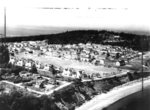At the height of World War II, Fort Worden resembled a modern-day suburban development.
There were more than 250 buildings covering the fort’s 400 acres, with many of them north of the parade …
This item is available in full to subscribers.
We have recently launched a new and improved website. To continue reading, you will need to either log into your subscriber account, or purchase a new subscription.
If you had an active account on our previous website, then you have an account here. Simply reset your password to regain access to your account.
If you did not have an account on our previous website, but are a current print subscriber, click here to set up your website account.
Otherwise, click here to view your options for subscribing.
* Having trouble? Call our circulation department at 360-385-2900, or email our support.
Please log in to continue |
|


At the height of World War II, Fort Worden resembled a modern-day suburban development.
There were more than 250 buildings covering the fort’s 400 acres, with many of them north of the parade ground dotting the slopes of Artillery Hill. Today, less than a third of the buildings remain.
When the war ended, the troops departed, leaving many of the buildings empty. In the early 1950s, the Korean War brought the troops back for the last great gathering of soldiers to be stationed at the fort. At war’s end in 1953, with the guns gone and many of the buildings vacant, the 50-year-old Army post was decommissioned.
TREATMENT CENTER
The local business community, realizing the need to find a new client to fill the buildings and the economic void the Army’s departure created, worked with federal and state officials to find a proper tenant. The result was the creation of a juvenile treatment and diagnostic center as part of the state’s correctional facilities program.
Even with the arrival of staff and students, there were more buildings available than the treatment center needed. To avoid the costs of maintaining the unused buildings, the state put the surplus structures up for sale.
The Aug. 29, 1959 edition of The Leader noted 40 buildings were for sale. The surplus buildings included the bowling alley, recreation hall, NCO club, post exchange, and quarters for both officers and enlisted personnel.
Many of the bids were awarded to local residents, although six double barracks buildings were purchased by a Whidbey Island developer. The structures were loaded aboard barges at the Fort Worden dock and ferried across Admiralty Inlet to be renovated and converted to apartments in the Oak Harbor vicinity. The locally purchased units were moved into town, where some of them remain to this day.
Two of the buildings were located at the Jefferson County Fairgrounds (one is still in use as the 4-H Cat Building). The Port of Port Townsend also purchased and placed two buildings at the airport. A few of the structures became private residences in town and were located in neighborhoods off Sheridan, Holcomb and Hendricks streets.
Some of the buildings were not sold, but were moved to new sites within the fort. One in particular is now one of the fort’s most popular houses. The story goes that while medical staff were being recruited for the juvenile treatment center, a prospective applicant was willing to accept a position provided she could obtain a living space with a view. The treatment center staff agreed and moved one of the small cottages to the bluff overlooking the beach and Fort Worden dock. The cottage is still in use and is aptly named Bliss Vista.
GLAMPING
Today, 73 buildings remain at the fort out of the 259 that existed nearly 75 years ago. Through the efforts of the Fort Worden Public Development Authority (PDA), the remaining buildings are undergoing extensive renovations, including the Guardhouse, houses 4E and 4W, and Bliss Vista. As for the buildings that were moved, their foundations remain, providing the PDA with the opportunity to reuse the foundations for the “glamping” sites currently in the preparatory construction stage.
Tim Caldwell served as a founding board member of the Fort Worden Public Development Authority and currently works in Guest Services at the fort, a position that includes researching the fort’s military and civilian history. He is writing this column monthly for The Leader.